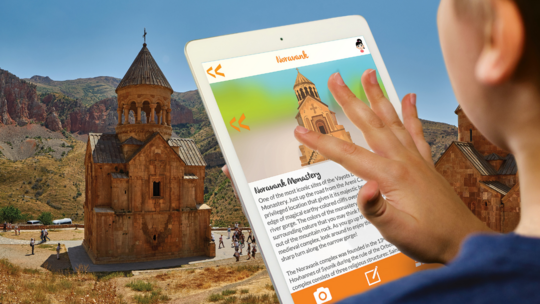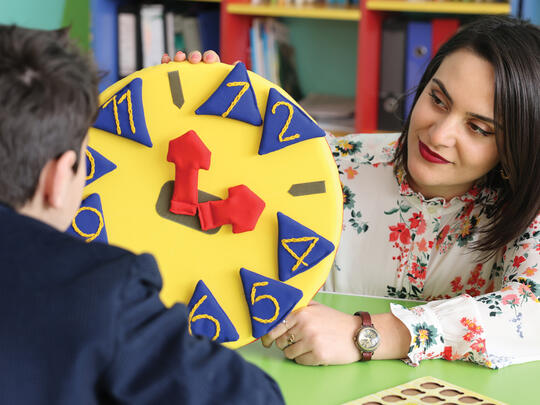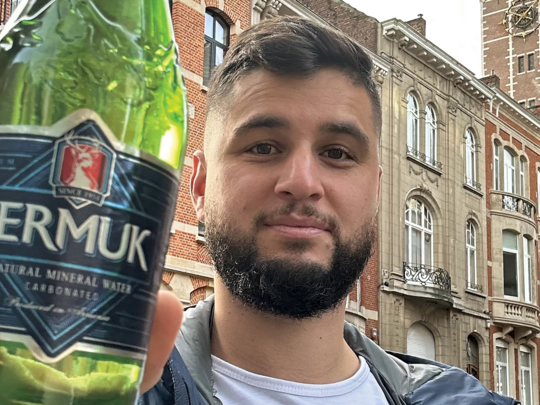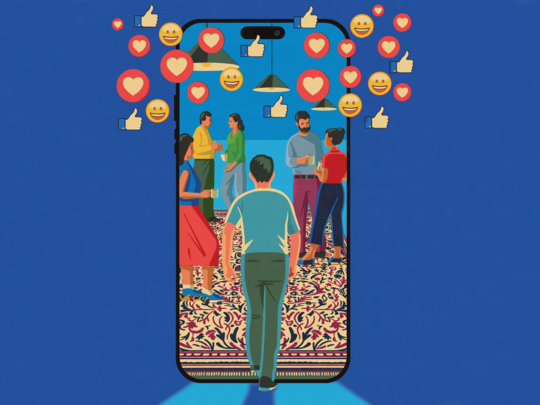
Armenian Heritage on Demand
The familiar faces of Armenian identity—Language, History, Culture, and Traditional Values—have presented an existential challenge ever since Armenian national identity reached its peak in the 5th century A.D., often referred to as Armenia’s Golden Age. During this period, the foundations of Armenia’s national character emerged, with cultural and intellectual output flourishing in all spheres of endeavor. Yet with each successive loss of sovereignty, passing down this rich Armenian inheritance to new generations would prove to be an exercise of diminishing returns, leading up to the postmodern era and the powerful sway of globalization in shaping identity among youth. Instilling the Armenian spirit in children—before they are fully socialized into the dominant culture—is the urgency of the day.
Ironically, the digital technology that spawned globalization in the first place is fast becoming the new best friend of Armenian Education. Silicon Valley has met Ararat Valley, transferring heritage to anyone, anywhere on earth, on demand. For those seeking to reconnect with their roots, expose their children to their ancestral birthright or familiarize themselves with Armenian life, a great place to start is AGBU and its three mobile applications: Gus on the Go: Armenian for Kids; Im Armenia; and Armenian Holidays & Traditions.
All three apps can be downloaded on any Android or iOS-smart device, providing access to a vast repository of educational content that would otherwise require many hours of research, day school semesters or Saturday classes. It’s all been curated, digitized and formatted for instant insight, answers and enjoyment.
“Our new focus on e-learning initiatives demonstrates AGBU’s long history for adapting to the changing landscape of education,” explains Ani Manoukian, an AGBU Central Board member who recognized early on that digital learning was an ideal fit for the Armenian world—especially the diaspora. “Building on the momentum of our successful Armenian Virtual College (AVC) program, we knew that e-learning was a viable direction for the future of AGBU’s educational programs,” she noted.
Today, Natalie Gabrelian heads up an entire department dedicated to making that decision a reality. As the director of Alternative Education at AGBU’s Central Office in New York, Gabrelian put it this way: “If the electronic age has taught us anything, it’s that learning can be fun, flexible and fulfilling in ways unimaginable even a decade ago.”
With those goals in mind, AGBU began pioneering innovative teaching tools back in 2014, with the successful release of the three apps a year later. By Gabrelian’s account, “Even non-Armenians visiting Armenia or marrying into an Armenian family are using the apps to better understand the classic Armenian heritage.” She also pointed out that for Armenian families living far from local Armenian community life, the apps are an affordable and convenient way to expose their children to the language, history and values of their ancestors. No doubt the parents will also learn something along the way.
Children from two to 13 and adults of all ages can connect to content at will to whatever extent they choose.
Gus on the Go
Armenian vocabulary in 90 words or less
gusonthego.com
Conceived as an early childhood language app for preschoolers under five, Gus on the Go: Armenian for Kids, is a platform for teaching secondary languages. Developed by toojuiceLLC, the popular app supports 28 different languages including Eastern and Western Armenian—thanks to a collaborative partnership with AGBU. The app exposes children to the Armenian language through interactive vocabulary lessons and games.
Recognized by parenting and teaching blogs as one of the best language learning apps, “Gus on the Go makes language learning enjoyable for the whole family,” according to Parents magazine. The easy to use, colorful app features Gus, a friendly owl and is narrated by native speakers. The user is guided through a country map with iconic landmarks, visiting towns like Gyumri, the capital city of Yerevan or the village of Tatev, known for the medieval monastery that sits atop a mountain plateau, in addition to exploring numerous other memorials and monuments like Sardarabad.
Animation enhances the user experience as children learn basic vocabulary concepts with interactive visual and auditory exercises related to numbers, colors, shapes, food, animals and more. Each lesson review includes exciting vocabulary games that reinforce the content learned in earlier sections. The fun continues at gusonthego.com with free downloadable and printable activities, including numbers flashcards, a zoo animal fortune-teller and transportation wheels in both Western and Eastern Armenian. Perfect for the classroom, playroom or a child’s bedroom, the Gus on the Go colorful Armenian alphabet posters (available through the AGBU Bookstore) make learning Armenian letters fun and easy.
To date, Armenian versions of Gus have been downloaded more than 3600 times since the app was launched with new users signing in every day from across the world. “Whether you are teaching children, reinforcing your own knowledge of basic vocabulary or exploring Armenian as a new language, the Gus app is suited to beginners of all ages,” Gabrelian explained.
Im Armenia (My Armenia)
Time travel on tap
imarmenia.org
Im Armenia, conceived in-house at AGBU and developed in Armenia, takes elementary through middle school-aged children on a virtual journey through Yerevan and the surrounding regions. The first digital travel guide to introduce youth to the historical sites and landmarks of the homeland, Im Armenia functions in English, Portuguese and French, catering to the large concentrations of Armenians in the United States and United Kingdom, Brazil, France, Lebanon and Canada.
Nonetheless, it is not surprising that nearly 70% of downloads are from the U.S., given the high numbers of Armenian-American visitors to the Republic of Armenia every year. The app is also catching on in other nations with a sizeable Armenian presence such as Russia, the Middle East, Australia and Argentina. There have even been downloads from China, Sweden and Germany, reflecting Armenia’s growing diaspora.
According to Manoukian, who came up with the Im Armenia concept, “On a recent trip to Armenia with our two young children, it became increasingly frustrating having to explain what they were looking at to keep them engaged. I thought, there really has to be a better way to instill in them an appreciation of their Armenian heritage without it seeming like a lecture from their parents.” She goes on to say that, “Children are going to be consuming electronic games and entertainment apps anyway, so why not expose them to their Armenian identity through the same interactive experience?”
User reviews have praised the app for “giving children history lessons without trying,” with others remarking that “it doesn’t feel like homework.” Maria Stepanian, mother of two teenage boys, remarked: “We just took our children to Armenia for the first time and they loved using Im Armenia! They enjoyed setting up their profile and reading about each site before arriving there. It was exciting for them to find some of the hidden symbols at each site.”
While the graphics and text are appropriate for children, the content rivals any basic travel guide for adults. Furthermore, Im Armenia offers added functionality so that users can take and store photos of their visits to popular sites like the Matenadaran, Cascade, and Tzitzernakaberd and keep a travel journal all from the same app. This makes Im Armenia a travel-light option for a family vacation, particularly when venturing out beyond Yerevan. So many ancient gems and hidden corners of the countryside are open to discovery and adventure, all from the palm of the hand.
Among the close to 30 sites covered are the prehistoric archeological treasures of the Areni Cave at Vayots Dzor, site of the world’s oldest leather shoe and home to the famous Areni wine. The app is a perfect complement to a tourism eBook called Vayots Dzor, part of a series of electronic travel guides geared to adults created by AGBU Armenian Virtual College (AVC). In addition, the Ararat region offers the clearest view of majestic Mt. Ararat, the backdrop for Khor Virap, the site on which St. Gregory the Illuminator was imprisoned in a deep pit. Another sightseeing favorite for any age is Lake Sevan, the “blue pearl of Armenia,” located in the Gegharkunik region.
Armenian Holidays & Traditions
Instant insights on authentic Armenian life
armenianholidaysandtraditions.org
Anyone who believes that old world values can’t be taught with new school methods hasn’t tried Armenian Holidays & Traditions. Another brainchild of the AGBU Alternative Education team, the software, much like the rich heritage it brings to life, is developed in Armenia. Engaging with this app is like stumbling upon an heirloom chest in your grandmother’s attic and discovering a vibrant tapestry woven of Armenian customs, rituals, values and more, dating back to the early Armenian Christian era up to the present day.
In addition to explaining major holidays like Easter Sunday and Armenian Christmas, the app features lesser-known historical markers like Holy Translators Day (Srpots Tarkmanchats Don in October) and Day of the First Republic (Arachin Hanrabedootian Or on May 28). More contemporary observances unique to Armenia include Earthquake Remembrance Day (Yegherni Hishadagi Or on December 7), Independence Day (Angakhootian Or on September 21) and Victory Day (Haghtanagi Or on May 9), among others.
“This app brings fresh meaning to holidays and observances that we often take for granted, that our families follow by rote, or which aren’t practiced outside of Armenia,” remarked Gabrelian. Armenian Holidays & Traditions not only explains but also amplifies learning by including the expressions, songs, dishes and customs associated with each occasion—complete with audio tracks and recipes. For Elizabeth Aslanian-Lorenzoni, a media executive in Chicago, Armenian Holidays & Traditions has revitalized holiday traditions. “I love this app,” she says. “Knowing what special dishes, songs and rituals belong to the day adds color and nuance to our celebrations. And with the “add to calendar” feature, we never miss an important day.”
One can just imagine an Armenian in the U.S. discovering there’s an equivalent of St. Valentine’s Day in Armenia called Feast of St. Sarkis. Whereas Valentine’s Day is all about sweets and flowers, the Feast of St. Sarkis calls for special cookies prepared with only salt and flour. Apparently, the high salt content causes excessive thirst, making dreams more vivid. The person in the dream who brings water to quench the dreamer’s thirst is revealed as his or her future spouse. Such is the intriguing lore and rich detail that bring new insight and perspective on Armenian culture.
While nearly 80% of downloads are from the U.S. and Canada, others are from such unlikely places as Israel, Hong Kong, and China. With a version in Western Armenian coming to market soon, usage is expected to reach even wider.
When Armenia regained its independence in 1991, the Internet had not yet gone public and Armenian identity was waning, even in Armenia after 70 years under Soviet rule. Nonetheless, Pulitzer-prize winning poet and bestselling author Peter Balakian had the vision to declare, “There’s never been a better time to be Armenian.” And thanks to the digital revolution and progressive initiatives from organizations like AGBU, it’s also never been easier.
Originally published in the August 2018 issue of AGBU Magazine.
























